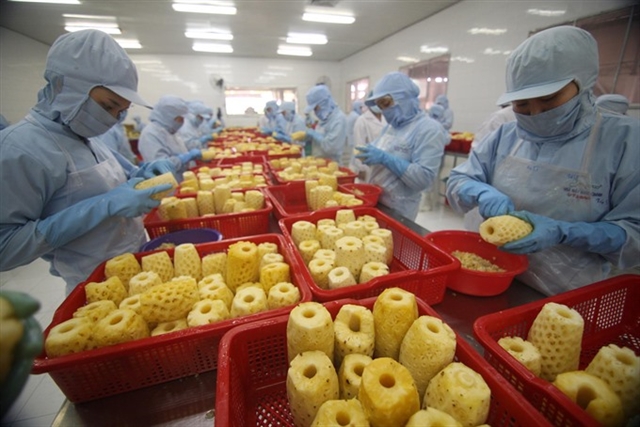 Economy
Economy


|
| A fruit processing line at An Giang Fruits-Vegetables and Foodstuff Joint Stock Company. — VNA/VNS Photo Vũ Sinh |
HÀ NỘI — The agricultural sector has determined to improve quality to meet import market standards and achieve the export target of US$10 billion by 2030.
Đặng Phúc Nguyên, general secretary of the Việt Nam Vegetables Association, said that new-generation free trade agreements (FTAs) such as the EU-Việt Nam Free Trade Agreement (EVFTA); the Comprehensive and Progressive Agreement for Trans-Pacific Partnership (CPTPP); or Regional Comprehensive Economic Partnership (RCEP) were helping pave the way for Vietnamese businesses to increase fruit and vegetable export turnover this year.
Regarding the market, vegetables and fruit exported mainly to the Chinese market in the first two months of this year, reached $352.83 million, up 17.5 per cent over the same period last year, accounting for 62.5 per cent of the total export value of vegetables and fruit of Việt Nam.
The increase in exports to the Chinese market is due to a sharp growth in consumption demand during the Lunar New Year. Besides China, some other major markets for Vietnamese fruits and vegetables are the US, Thailand, Japan, and South Korea.
Notably, the export value of vegetables and fruits to Taiwan, Australia and Malaysia rose significantly. Export value to the Taiwanese market reached $12.87 million, up 43.1 per cent; Australian market reached $11.9 million, up 30.6 per cent; and the Malaysian market reached $9.2 million, up 32.5 per cent over the same period last year.
In addition to familiar markets, Việt Nam's fruit and vegetable industry has also been promoted for export to many other large potential markets, such as Egypt, Kuwait, Ukraine, and Senegal.
The UK – Việt Nam Free Trade Agreement (UKFTA) promises to create a new driving force for economic co-operation in the future, said Nguyên.
When the agreement takes effect, more than 94 per cent of the total 547 tax lines for vegetables and fruit will have a tax rate of 0 per cent.
Many key products such as litchi, longan, rambutan, dragon fruit and pineapple will have additional market access advantages as tropical fruits originating from competing countries such as Brazil, Thailand and Malaysia do not have FTAs with the UK.
To take advantage of market opportunities and boost exports, businesses need to improve the quality of fruit and vegetable products and meet the standards required by the importing market, said experts.
Recently, the Prime Minister has approved a project to develop the fruit and vegetable processing industry in the 2021-2030 period with the goal that export turnover of fruits and vegetables will reach $8-10 billion by 2030.
Of which, the proportion of export turnover of processed fruit and vegetable products will reach 30 per cent or more; fruit and vegetable processing capacity will reach two million tonnes per year, nearly double that of last year.
On the other hand, the project also aims to attract investment for 50-60 new large and medium-sized fruit and vegetable processing establishments by 2030; to build and successfully develop a number of modern fruit and vegetable processing groups and enterprises at regional and international level.
To achieve these goals, the agricultural sector will boost investment in improving the capacity of fruit and vegetable processing in the future; develop establishments for preliminary processing and preservation of fresh fruits and vegetables as well as promoting key fruit and vegetable products and high value-added products.
In addition, the agricultural sector will promote deep processing, diversify products from raw vegetables and fruits and from post-processing by-products. The industry will also strive for value-added growth of 10 per cent per year on average in the 2021-2030 period.
The sector will also build and form specialised areas in vegetable and fruit production to ensure the supplied materials to have quality and food safety for processing activities. — VNS